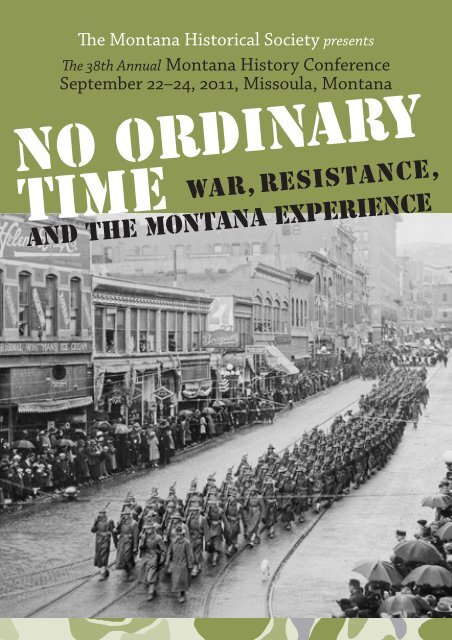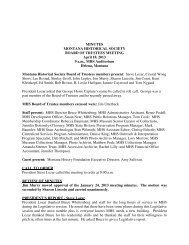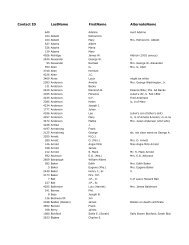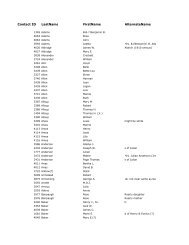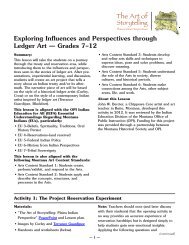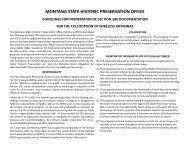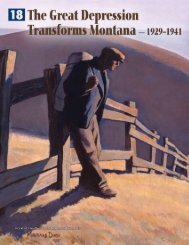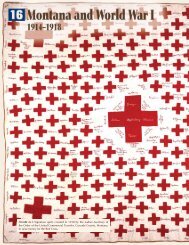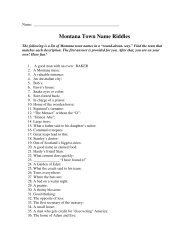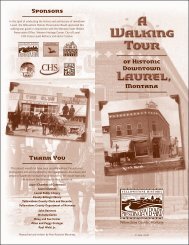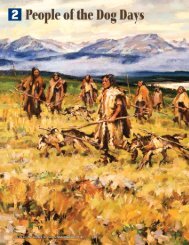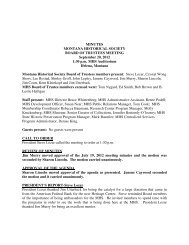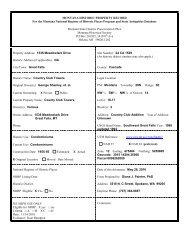Brochure - Montana Historical Society
Brochure - Montana Historical Society
Brochure - Montana Historical Society
Create successful ePaper yourself
Turn your PDF publications into a flip-book with our unique Google optimized e-Paper software.
The <strong>Montana</strong> <strong>Historical</strong> <strong>Society</strong> presents<br />
The 38th Annual <strong>Montana</strong> History Conference<br />
September 22–24, 2011, Missoula, <strong>Montana</strong><br />
No Ordinary<br />
Time<br />
WAR, RESISTANCE,<br />
AND THE MONTANA EXPERIENCE
No Ordinary Time . . . From the time of the First Peoples to the<br />
present day, conflict has always been part of the <strong>Montana</strong> story. Join us in<br />
Missoula for the 38th annual <strong>Montana</strong> History Conference to explore the<br />
role of warfare in traditional Native American culture, the contributions that<br />
<strong>Montana</strong>ns have made to our nation’s wars, the impact that those wars had<br />
on life in the Treasure State, and the efforts of those who fought to resist<br />
armed conflict. To commemorate the 70th anniversary of the United States’<br />
entry into WWII, conference highlights will include sessions on, and a visit<br />
to, Fort Missoula, which served as an internment camp for Italian detainees<br />
and Resident Alien Japanese during World WWII. Thursday’s workshops will<br />
offer hands-on, practical experiences, while Saturday’s field trips will provide<br />
firsthand encounters with historic sites significant to <strong>Montana</strong>’s military<br />
past. Join MHS and our Missoula partners—The <strong>Historical</strong> Museum at Fort<br />
Missoula, The <strong>Montana</strong> Museum of Art & Culture, and The University of<br />
<strong>Montana</strong>—in this enlightening and informative gathering.<br />
Conference logistics: Unless otherwise noted, all events will be held at the<br />
DoubleTree by Hilton Missoula-Edgewater, 100 Madison St., Missoula. A block<br />
of rooms is being held for conference-goers at the DoubleTree until August 26.<br />
To make reservations, visit doubletree.hilton.com or call 406.542.4600.<br />
Be sure to ask for the <strong>Montana</strong> History Conference rate or use group block code<br />
MTHI0929 if registering online. Other nearby accommodations can be found at<br />
www.visitmt.com.<br />
Fight between Cheyenne and Comanche Indians (detail), White Bear, colored pencil and<br />
graphite on paper, 1885<br />
2<br />
<strong>Montana</strong> <strong>Historical</strong> <strong>Society</strong>,<br />
gift of Francis Jergens Tobie, x1961.16.02
PAc 84-34<br />
Teacher credit: Up to twenty-two OPI Teacher Renewal Units are available for<br />
conference attendees. Teachers desiring renewal credits may obtain forms and<br />
additional information at the conference registration table.<br />
Pre-conference opportunity: The <strong>Montana</strong> Preservation Alliance will be hosting<br />
its Preservation Excellence Awards Ceremony on Wednesday, September 21,<br />
5:30 p.m., at the Florence Hotel, 111 N. Higgins Ave., Missoula. For more<br />
information visit www.preservemontana.org or call 406.457.2822.<br />
Thursday, September 22 (Conference schedule is subject to change.)<br />
S 7:30 a.m.–6:30 P.m. Conference registration<br />
S 8:30 a.m.–4:30 P.m. All-day workshops (include lunch)<br />
“ V for Victory”<br />
work party of<br />
Italian detainees,<br />
Fort Missoula,<br />
1942<br />
Educators Workshop Many teachers successfully use primary sources to<br />
engage and excite students about history, teach media literacy, and introduce<br />
the art of historical research. The <strong>Montana</strong> <strong>Historical</strong> <strong>Society</strong> is making it easy<br />
for <strong>Montana</strong> educators to harness The Power of Primary Sources in the Classroom.<br />
In keeping with the conference theme, the workshop will focus on war<br />
and resistance, from the Indian Wars through the Gulf War. Participants will<br />
learn where to find and how to analyze primary sources relating <strong>Montana</strong>ns’<br />
experience during wartime, including material on the Library of Congress’s<br />
American Memory and Veterans Oral History Project websites, the <strong>Montana</strong><br />
<strong>Historical</strong> <strong>Society</strong>’s website, and the <strong>Montana</strong> Memory Project website.<br />
3
Hands-on activities will offer participants opportunities to hone their primary<br />
source analysis skills. Participants will also learn about educational technologies<br />
(like Glogster and Animoto) and programs (like Teaching with Primary Sources<br />
and National History Day) that make it easier to integrate primary sources into<br />
the classroom. Presenters will include Martha Kohl, historical specialist at the<br />
<strong>Montana</strong> <strong>Historical</strong> <strong>Society</strong>, Dr. Tom Rust, co-director of <strong>Montana</strong> National<br />
History Day, and Peggy O’Neill-Jones, director of Teaching with Primary<br />
Sources–Colorado.<br />
Collections Care Workshop The <strong>Montana</strong> State <strong>Historical</strong> Records<br />
Advisory Board (SHRAB) will present a workshop titled What to Keep: The<br />
Funda mentals of Archival Appraisal. It will focus on one of the most complex<br />
aspects of archival collection management—deciding what to keep, what to<br />
send elsewhere and where to send it, and what to deaccession if it is already in<br />
your collection. Attendees will gain practical knowledge of how archival appraisal<br />
differs from monetary appraisal, how appraisal affects and is effected by your<br />
collection policies, which state laws effect appraisal issues, and how to document<br />
the appraisal choices that you make. Advisory Board members will lead the<br />
instruction. Attendees are encouraged to bring examples of appraisal problems<br />
to stimulate discussion. This daylong workshop will also include helpful<br />
handouts and information on other resources.<br />
S 8:45 a.m.–5:00 P.m. Made in <strong>Montana</strong> Tour (vans depart from the DoubleTree,<br />
includes lunch)<br />
Third Annual Made in <strong>Montana</strong> Field Trip (limited to 20 participants).<br />
This year’s tour will focus on the Bitterroot Valley, beginning at the Rocky Mountain<br />
Labs with a tour led by Dr. Marshall Bloom, Associate Director for Science<br />
Management, Division of Intramural Research. Built in 1928 to investigate<br />
Rocky Mountain Spotted Fever, today the Hamilton lab employs 400 people<br />
in biomedical research studying vector-borne diseases. Other venues include a<br />
visit to Glaxo-Smith-Kline Pharmaceuticals which is the only place in the world<br />
that makes a specific vaccine for cervical cancer; the Huls Dairy, which has been<br />
in business since 1908—milking almost 400 cows daily—and which three years<br />
ago built a methane digester to turn manure into energy; and the 50-room Daly<br />
Mansion, designed and built by A. J. Gibson, Missoula’s most significant architect,<br />
for Butte Copper King Marcus Daly and his wife.<br />
4
S 12:00 P.m.–5:00 P.m. Half-day workshop (includes lunch)<br />
Preservation Workshop The workshop begins with a lunchtime presentation<br />
by Paul Lusignan, Historian, National Park Service National Register<br />
Program, Washington, D.C., who will give a short talk about the National<br />
Register and some of its most interesting properties from across the nation.<br />
Following lunch, Lusignan will present an in-depth look at Demystifying<br />
Modern ism and the National Register of Historic Places. Topics will include the<br />
National Register nomination process focusing on the procedure, requirements,<br />
and challenges of completing successful documentation. Lusignan will also<br />
provide an interesting and helpful program regarding significant properties<br />
from the “recent past,” with an emphasis on Modern architecture.<br />
S 6:30 P.m.–7:30 P.m. Opening reception<br />
Native Words, Native Warriors When the United States issued the<br />
call to arms in World Wars I and II, American Indians answered and some<br />
discovered that words—in their Native languages—would be their most valued<br />
weapons. The 38th annual <strong>Montana</strong> History Conference will open by paying<br />
homage to these “code talkers” with the display of the Smithsonian Institution’s<br />
traveling exhibit, Native Words, Native Warriors. Join us in honoring these<br />
soldiers and their unique contributions to America’s war efforts, then meet and<br />
greet fellow conference-goers, browse the MHS book store and Museums Association’s<br />
silent auction, have your books signed by history conference authors,<br />
and enjoy light hors d’oeuvres and a no-host bar. Native Words, Native Warriors<br />
will be on exhibit throughout the conference.<br />
S 7:30 P.m.–9:00 P.m. Keynote address<br />
<strong>Montana</strong>, Lincoln, and the Civil War In a<br />
slide-illustrated presen tation, Dr. Richard Etulain will<br />
provide an in-depth and engaging look at the American<br />
West during the period of the American Civil War.<br />
His lecture will examine the impact that the players,<br />
most especially Abraham Lincoln, and the issues—<br />
like slavery and emancipation, civil rights, political<br />
conflicts, and northern and southern attitudes and<br />
actions—had on the territories far removed from Dr. Richard Etulain<br />
5<br />
Brian Libby, photog.
947-247<br />
the eastern battlegrounds. Etulain, who is Professor Emeritus of History at<br />
the University of New Mexico and author of almost fifty publications, is widely<br />
regarded as the premiere American scholar on the topic of Abraham Lincoln and<br />
the American West. This session is sponsored by Humanities <strong>Montana</strong> and is<br />
free and open to the public.<br />
Friday, September 23<br />
S 7:30 a.m.–5:30 P.m. Conference registration<br />
S 7:30 a.m.–8:50 a.m. Plenary session (breakfast<br />
included)<br />
Rethinking Warfare in Traditional<br />
American Indian Societies Following<br />
breakfast and a welcome by MHS Board of<br />
Trustees President Steve Lozar, Mike Jetty—Indian Education Specialist with<br />
the <strong>Montana</strong> Office of Public Instruction, Helena, and enrolled member of the<br />
Spirit Lake Dakota—will provide historic examples of the ways in which <strong>Montana</strong>’s<br />
Tribal Nations structured their warrior societies and how the concept<br />
of warfare was perceived. Mike will also share contemporary examples of how<br />
warrior society traditions are being maintained and revitalized today.<br />
S 9:00 a.m.–10:15 a.m. Concurrent sessions<br />
Mike Jetty<br />
Friends and Foes From territorial days through present times,<br />
the presence of military installations has had a significant impact on<br />
Company “E”<br />
Third Infantry,<br />
Fort Ellis, 1886<br />
7
the communities in which they were located. This session will examine two<br />
early examples of the interaction between the military and its civilian<br />
neighbors. In War and Prostitution: The Makings of Miles City, Lael Morgan,<br />
photo -journalist and instructor of media writing, University of Texas,<br />
Arlington, will explore the ties between war, prostitution, and the growth of a<br />
major <strong>Montana</strong> city with an entertaining focus on the characters who insured<br />
this successful byproduct of military planning. In My Duties Are Not So Clearly<br />
Laid Down: Mission Clarity, Political Pressure, and Operational Frustration on<br />
<strong>Montana</strong>’s Military Frontier, Dr. Tom Rust, professor of history at MSU–Billings,<br />
will—using Bozeman and Fort Ellis as a case study—examine the frustration<br />
encountered by U.S. Army officers charged with the dual, and often conflicting,<br />
missions of protecting civilians from Indian incursions, as well as Indians from<br />
settlers’ provocations and exploitation.<br />
The Civil War in <strong>Montana</strong> History and Literature In <strong>Montana</strong>,<br />
the Civil War was fought over two questions: What would be the relationship<br />
between the territory and the federal government? And who would be considered<br />
inside the body politic and who would be the outsiders? In We the<br />
People, Tim Lehman, professor of history at Rocky Mountain College, Billings,<br />
and Robert Swartout, professor of history at Carroll College, Helena, will<br />
explore these issues from the historian’s perspective. In Telling Tales of War,<br />
Ken Egan, executive director of Humanities <strong>Montana</strong>, Missoula, will show how<br />
these themes play out in both early <strong>Montana</strong> writing—such as the memoirs<br />
of Yellowstone Kelly and Andrew Garcia—as well as in more contemporary<br />
renderings such as James Welch’s Fools Crow.<br />
Rather than War During World War II, for the first time in American history,<br />
the Civilian Public Service (CPS) program provided conscientious objectors<br />
a legal alternative to military service. This unusual church-state partnership<br />
afforded more than 12,000 men the opportunity to perform “work of national<br />
importance,” but not as combatants. These men undertook work ordinarily<br />
accomplished by federal employees, primarily through camps administered<br />
by the Quaker, Brethren, and Mennonite church organizations. By focusing<br />
on specific aspects of this story our three speakers will, together, provide an<br />
overview of the CPS program across <strong>Montana</strong>: Marcella Sherfy Walter, former<br />
education officer for the <strong>Montana</strong> Heritage Program, Helena, will present<br />
Memories from the Civilian Public Service Camp #55 Crew Who Maintained Glacier<br />
National Park; Terri Wolfgram, BLM Archaeologist, Belgrade, will share her<br />
8
957-943, A. B. Coe, photog.<br />
research into Civilian Public Service Camp #64 at Terry, <strong>Montana</strong>; and Shandy<br />
Lemperlé, Archives Manager, USDA Forest Service, Missoula, will discuss<br />
The Role of Conscientious Objectors in Smoke Jumping during World War II.<br />
S 10:15 a.m.–10:30 a.m. Break<br />
S 10:30 a.m.–11:45 a.m. Concurrent sessions<br />
The Archaeology of War—From the Ground to the Public<br />
Domain This session will examine three perspectives of war and conflict<br />
with an archaeological twist. Tom Milter will describe the context and history<br />
of the Battle of the Rosebud, exploring how recovered munitions may reveal<br />
troop movements. Helen Keremedjiev will examine Public Interpretation<br />
Methods at <strong>Montana</strong>’s Historic Battlefields, focusing on the Bears Paw, Big<br />
Hole, Little Bighorn, and Rosebud battles. Jackson Mueller will tell Tales from<br />
the Trash: The Fort Missoula Garbage Dump, exploring the daily lives of ordinary<br />
soldiers through what may be their most intimate legacy, their garbage.<br />
All three panelists are anthropology graduate students at the University of<br />
<strong>Montana</strong>, Missoula.<br />
Minorities in the Military MHS Interpretive Historian Dr. Ellen Baumler<br />
will provide an overview of the role played by African Americans in the military<br />
in her presentation, Vignettes of Valor. Baumler will examine the important<br />
Tenth Cavalry escort party at lunch, St. Mary’s, 1894<br />
9
and varied contributions—both on and off the battlefield—of such notable<br />
<strong>Montana</strong>ns as Isaiah Dorman who fell with Custer at the Battle of the Little<br />
Bighorn, fourteen-year-old James Crump who served in the Union Army and<br />
became <strong>Montana</strong>’s youngest civil war veteran, and WWII army nurse Octavia<br />
Bridge water who fought for the rights of black nurses. Billings historian,<br />
preservationist, and genealogist Ann Ferguson will reveal in-depth The Story<br />
of Horace Bivens, a Virginia native who settled in Billings following a colorful<br />
and meritorious military career that spanned three decades.<br />
Success and Failure on the Military Frontier In Camp Cooke:<br />
First Military Post in <strong>Montana</strong>, Rodger Huckabee, educator and historian, Kuna,<br />
Idaho, will relate the ups and downs of <strong>Montana</strong>’s first army post, from the time<br />
it was established at an ill-advised location on the banks of the Missouri River<br />
in 1866 until it was closed and soldiers moved to Fort Benton less than four<br />
years later. Jim Court, Billings resident and former Superintendent of Little<br />
Bighorn Battlefield National Monument, will tell Stories from the Battlefield<br />
as he discusses the 1876 battle, modern archeological work at the battlefield,<br />
and life as superintendent of one of the nation’s best known, and often<br />
controversial, historic sites.<br />
S 12:00 P.m.–1:30 P.m. Awards luncheon<br />
Food, Power, War Following the presentation<br />
of the 2011 MHS Board of Trustees Heritage Keeper<br />
Awards, Dr. Mary Murphy, award-winning author<br />
and Professor of History, <strong>Montana</strong> State University,<br />
Bozeman, will explain how those gleaming, innocuous<br />
Mason jars of preserved vegetables took on<br />
many meanings during WWI. Murphy will examine<br />
the homefront through the lens of gender, as issues<br />
of food production and consumption fell squarely<br />
on women’s shoulders, increasing their political participation during the war<br />
years. Women cast their traditional tasks of cooking, preserving, and serving<br />
food in the light of patriotism; they raised concerns about food production<br />
and distribution in the context of wartime profiteering; and they turned “spy”<br />
when they deemed necessary by reporting rationing infractions to the Food<br />
Administration.<br />
10<br />
Dr. Mary Murphy
S 1:45 P.m.–3:00 P.m. Concurrent sessions<br />
Serving Splendidly C. Milo McLeod, retired Master Sergeant, <strong>Montana</strong><br />
Army National Guard and U.S. Army Reserve, Missoula, will introduce this<br />
panel which will provide an overview of The <strong>Montana</strong> National Guard and Its<br />
History. Dr. Orlan Svingen, Professor of History, Washington State University,<br />
Pullman, and editor of the recently published book, Splendid Service: The<br />
<strong>Montana</strong> National Guard, 1867–2006, will provide<br />
the back story on Writing Splendid Service,<br />
explaining the process that led to publication<br />
and the issues faced by the contributors and<br />
the editor. Dr. Suzanne Julin, independent<br />
historian, Missoula, will discuss Slow and at<br />
Sometimes Discouraging: Building the <strong>Montana</strong><br />
National Guard in the Interwar Years. And<br />
Dr. Diane Krahe, assistant research professor,<br />
University of <strong>Montana</strong> History Department,<br />
Missoula, will detail the guard’s aerial history<br />
in Launching an Air Squadron into the Big Sky.<br />
Julin and Krahe are both contributing authors<br />
to Splendid Service.<br />
Fighting Prejudice at Home Matt Basso,<br />
Assistant Professor of History and Gender<br />
Studies and Director of the American West<br />
U.S. Food Administration poster,<br />
ca. 1918<br />
Center, University of Utah, Salt Lake City, will present Wartime Wildcat: Butte<br />
Miners, the Roosevelt Administration, and the Limits of Popular Front Interracialism.<br />
Basso will discuss a little-known wildcat strike launched by miners in 1942<br />
in response to the government’s effort to place furloughed black soldier-miners<br />
underground in the Mining City. The strike, which featured a diverse cast of<br />
Butte locals, called into question the reputation of Mine Mill’s rank and file for<br />
being at the forefront of Popular Front struggles for an interracial working class<br />
movement. Lyndel Meikle, interpretive historian at Grant-Kohrs Ranch, Deer<br />
Lodge, will examine Better than the Alternative, telling the story of how the<br />
Anaconda Company used the threat of hiring blacks and Mexicans to force the<br />
union to accept the marginally more acceptable (but still strongly objectionable)<br />
hiring of females during WWII. Both the company and the union will take hits,<br />
and a few voices of reason may be heard whispering in the background.<br />
11<br />
Library of Congress
Recording the Call to Arms MHS Government Records Archivist<br />
Jeff Malcomson will provide an overview of the Military History Resources at<br />
the <strong>Montana</strong> <strong>Historical</strong> <strong>Society</strong>, highlighting notable collections—including the<br />
<strong>Montana</strong> Adjutant General’s personnel card files, diaries of service members<br />
from various military engagements, oral histories, and related photographic<br />
collections—gathered by MHS over the past 150 years. Ellie Arguimbau, MHS<br />
Senior Archivist, will delve in-depth into The Hargis Westerfield Collection,<br />
which documents the service of the 41st Infantry Division in World War II<br />
in the Pacific. The collection consists primarily of Westerfield’s compilation<br />
of letters, reminiscences, and diaries of servicemen for articles in the<br />
Jungleer Magazine. Arguimbau will reveal some of the challenges encountered<br />
while working with the collection, as well as its significance to World War II<br />
military history.<br />
S 3:00 P.m.–3:15 P.m. Break<br />
S 3:15 P.m.–4:30 P.m. Concurrent sessions<br />
Over There, Over Here In his presentation, Jusqu’au Bout—To the Bitter<br />
End, MHS Oral Historian Rich Aarstad will recount the story of the 10th and<br />
20th Engineers Forestry in World War I. Aarstad will tell how this specialized<br />
unit was recruited and trained from the ranks of those who worked in civilian<br />
occupations related to the lumber industry and how—after receiving basic<br />
military training upon their<br />
PAc 76-26.212, Walter Dean Jr., photog.<br />
arrival in France—these<br />
troops were moved into the<br />
timbered regions of that<br />
country and began cutting<br />
and manufacturing lumber<br />
for the war effort. In War and<br />
Marriage and the <strong>Montana</strong><br />
Experience, Martha Kohl,<br />
<strong>Historical</strong> Specialist at the<br />
<strong>Montana</strong> <strong>Historical</strong> <strong>Society</strong><br />
and author of I Do: A Cultural<br />
History of <strong>Montana</strong> Weddings,<br />
will examine how wartime<br />
exigencies have intersected Draftees leaving for training, Forsyth, ca. 1917<br />
12
PAc 85-90<br />
with the decision to wed. Kohl will relate stories that illustrate how the prospect<br />
of war adds urgency to romance, how military regulations and wartime scarcity<br />
shape wedding ceremonies, and how the movement of large numbers of single<br />
men provides new courtship opportunities.<br />
Bases under the Big Sky Missoula author and publisher Stan Cohen<br />
will tell the little-known story of World War II’s Lend Lease Program which<br />
saw the delivery of over 8,000 aircraft to Russia from Gore Field in Great Falls<br />
via Nome, Alaska. Included as cargo were many personal items, industrial<br />
plans, and possibly even atomic secrets. Kate Hampton, MHS Community<br />
Preser vation Coordinator, will present They are our B-17s! a history of Norden<br />
Bombsight training facilities in Lewistown, Cut Bank, Glasgow, and Great Falls<br />
during World War II. The U.S. Army Air Corps constructed these unique and<br />
now extraordinarily rare facilities to train squadrons in navigation of the B-17<br />
“Flying Fortress” and use of the top secret Norden Bombsight.<br />
We Won’t Go In this year’s “Real Voices” session—which will be moderated<br />
by Helena journalist and former <strong>Montana</strong> Kaimin managing editor Chuck<br />
Johnson—three participants will discuss their personal experiences with<br />
Student Resistance to the Vietnam War on the University of <strong>Montana</strong> Campus.<br />
Diane Sands, <strong>Montana</strong> State Representative and Development Director, <strong>Historical</strong><br />
Museum at Fort Missoula, will talk about her work with draft resistance and<br />
other anti-war activities; Charlie Briggs, Vice President, Easter Seals–Goodwill,<br />
Missoula, will discuss how the Vietnam conflict caused him to quit Air Force<br />
ROTC and his work with UM’s Campus Reform Action Movement (CRAM); and<br />
Flo Chessin, one of the founding members of Missoula Women for Peace in<br />
1970, will talk about efforts of that group throughout the Vietnam War and its<br />
subsequent antiwar activities.<br />
CCC Camp serving<br />
conscientious<br />
objectors, Terry,<br />
WW I I<br />
13
Schedule at a Glance<br />
Unless otherwise noted, all events will be held at the DoubleTree by Hilton Missoula-Edgewater,<br />
100 Madison Street. Conference schedule is subject to change.<br />
Thursday, September 22<br />
7:30–6:30 Conference Registration<br />
8:30–4:30 All-day workshops (include lunch)<br />
Educators Workshop<br />
Collections Care Workshop<br />
8:45–5:00 Made in <strong>Montana</strong> Field Trip (includes lunch, limited to 20)<br />
12:00–5:00 Preservation Workshop (includes lunch)<br />
6:30–7:30 Opening reception—Native Words, Native Warriors<br />
7:30–9:00 Keynote address—<strong>Montana</strong>, Lincoln, and the Civil War<br />
Friday, September 23<br />
7:30–5:30 Conference Registration<br />
7:30–8:50 Plenary session—Rethinking Warfare in Traditional<br />
American Indian Societies (includes breakfast)<br />
9:00–10:15 Concurrent sessions<br />
Friends and Foes<br />
The Civil War in <strong>Montana</strong> History and Literature<br />
Rather than War<br />
10:15–10:30 Break<br />
Guard mount in buffalo coats, Fort Keogh, 1879<br />
14<br />
981-359, L. A. Huffman, photog.
10:30–11:45 Concurrent sessions<br />
The Archaeology of War<br />
Minorities in the Military<br />
Success and Failure on the Military Frontier<br />
12:00–1:30 Awards Luncheon—Food, Power, War<br />
1:45–3:00 Concurrent sessions<br />
Serving Splendidly<br />
Fighting Prejudice at Home<br />
Recording the Call to Arms<br />
3:00–3:15 Break<br />
3:15–4:30 Concurrent Sessions<br />
Over There, Over Here<br />
Bases under the Big Sky<br />
We Won’t Go<br />
5:00–8:00 Exhibit reception—War Torn: The Art of Ben Steele, The <strong>Montana</strong><br />
Museum of Art & Culture, UM Campus<br />
8:00–9:30 Presidential Lecture Series keynote address—The Cultures of War:<br />
Pearl Harbor/Hiroshima/9-11/Iraq, University Theater, UM Campus<br />
Saturday, September 24<br />
7:30–9:30 Conference registration<br />
7:45–9:30 Concurrent sessions (include breakfast)<br />
The War against Disease<br />
The Cold War in <strong>Montana</strong><br />
Rush to Glory<br />
10:15–11:45 Plenary session—Enemy Aliens, Post Headquarters Courtroom,<br />
Fort Missoula<br />
12:00–1:00 Lunch, Fort Missoula<br />
Post-conference activities<br />
1:00–1:30 Public Dedication Ceremony, Post Headquarters Courtroom, Fort Missoula<br />
1:30–4:30 Fort Missoula Tour<br />
1:30–4:30 Mullan Road/Council Grove Tour, departs from Fort Missoula<br />
(limited to 20)<br />
2:00–4:30 A. J. Gibson Walking Tour, departs from DoubleTree Hotel (limited to 20)<br />
15
Curated by George Horse Capture, Sr.,—a <strong>Montana</strong>n and member<br />
of the Gros Ventre tribe—for the National Museum of the American<br />
Indian, Smithsonian Institution, this traveling exhibit tells the<br />
remarkable story of Indian soldiers from more than a dozen tribes<br />
who used their native languages as a weapon against the enemies<br />
of the United States. Although World War II’s Navajo code talkers<br />
have received the most recognition, this exhibit tells the rest of the<br />
story—the role of code talkers in World War I and the contributions<br />
made by <strong>Montana</strong> tribal members.<br />
This exhibit was produced by the Smithsonian Institution’s Traveling Exhibit Service<br />
(SITES) and brought to the Treasure State by the <strong>Montana</strong> <strong>Historical</strong> <strong>Society</strong> through<br />
the generous support of:<br />
Dennis and Phyllis Washington Foundation, Missoula<br />
Indian Gaming Association<br />
Janene Caywood, Cultural Resources Consulting Services, Missoula<br />
Lone Rock School<br />
Marine Corps League Great Falls Detachment 688<br />
Marine Corps League Donald J. Ruhl Detachment 620, Helena<br />
<strong>Montana</strong> Governor’s Office of Indian Affairs<br />
Tamara and Myron Laib, Valley Hub & Laib-ation Station, Great Falls<br />
Smithsonian Institution, Museum of the American Indian, Washington, D.C.<br />
Wal-Mart
S 5:00 P.m.–8:00 P.m.<br />
Exhibit reception<br />
Join the <strong>Montana</strong> Museum of Art &<br />
Culture on the University of <strong>Montana</strong><br />
campus for the opening of its<br />
new exhibit, War Torn: The Art of<br />
Ben Steele, depicting paintings and<br />
drawings from the Bataan Death<br />
March. During World War II, Steele<br />
endured 41 months of starvation,<br />
dehydration, hard labor, torture, and<br />
Japanese “hell ships” while crippled Tayabas Road, Ben Steele, charcoal on paper, n.d.<br />
by dysentery, pneumonia, malaria,<br />
blood poisoning, and beriberi. The artist—now a resident of Billings—miraculously<br />
survived and later created a vast aesthetic and historical record that pays<br />
tribute to those who did not survive and offers a message of peace. Enjoy light<br />
hors d’oeuvres and a no-host bar before making the short walk over to the University<br />
Theater for the evening’s keynote address. For more information on the<br />
exhibit and related programming visit: www.umt.edu/montanamuseum or call<br />
406-243-2019.<br />
S 8:00 P.m.–9:30 P.m. Keynote address, University Theater, UM Campus<br />
In conjunction with the <strong>Montana</strong> History Conference,<br />
the University of <strong>Montana</strong>’s Presidential Lecture Series<br />
will present Dr. John Dower discussing The Cultures of<br />
War: Pearl Harbor/Hiroshima/9-11/Iraq. Dower—Professor<br />
Emeritus of History at the Massachusetts Institute<br />
of Technology and Pulitzer Prize-, Mellon Prize-, and<br />
National Book Award-winning author—has been hailed<br />
as being “without question . . . America’s foremost<br />
historian of the Second World War in the Pacific.” His<br />
Dr. John Dower most recent book, The Cultures of War, provides a groundbreaking<br />
comparison of four definitive acts of violence in<br />
our time, beginning on December 7, 1941, and continuing through the current<br />
war in Iraq. Books will be available for purchase and Dower will sign copies after<br />
his lecture which is free and open to the public.<br />
18<br />
<strong>Montana</strong> Museum of Art & Culture
Saturday, September 24<br />
S 7:30 a.m.–9:30 a.m. Conference registration<br />
S 7:45 a.m.–9:30 a.m. Concurrent sessions (include breakfast)<br />
The War against Disease Dr. Marshall Bloom, Associate Director for<br />
Science Management, Division of Intramural Research, Rocky Mountain<br />
Laboratories, Hamilton, will tell the tale of Battling Yellow Jack in the Bitterroot<br />
during World War II. Bloom will discuss efforts to establish a yellow-fever<br />
vaccine production facility at the National Institute of Health’s Hamilton<br />
laboratories where, after 1942, all yellow-fever vaccines for members of the U.S.<br />
armed forces—up to 100,000 doses per week—were produced. Ellen Leahy,<br />
Director of the Missoula County Public Health Department, will talk about the<br />
worldwide influenza epidemic as it affected the Garden City and the role of Fort<br />
Missoula in the spread of the disease in her presentation on Our Hour of Proof:<br />
The 1918 “Spanish” Influenza Pandemic in Missoula. This session on the Treasure<br />
State’s medical history is sponsored by Dr. Volney Steele, Bozeman.<br />
The Cold War in <strong>Montana</strong> In his presentation, Keep Watching the Skies,<br />
<strong>Montana</strong> Department of Transportation Historian Jon Axline, Helena, will tell<br />
the story of Operation SKYWATCH and the <strong>Montana</strong> Ground Observer Corps.<br />
Beginning in 1952, the Air Force trained thousands of <strong>Montana</strong> civilians to<br />
scan the skies, report on unidentified aircraft, and plot their positions in case<br />
of a Soviet sneak attack. They were on the<br />
front line of the Cold War until the Air Force<br />
established radar stations throughout the<br />
state in 1958. In her talk, Nuclear <strong>Montana</strong>,<br />
Molly Holz, editor of the MHS Publications<br />
program, will recount the history of Minuteman<br />
missiles in <strong>Montana</strong> and show how the<br />
missiles thrust a remote and rural state into<br />
the center of international affairs during the<br />
Cold War. Today, 150 Minuteman missiles dot<br />
the state. Although the missiles themselves<br />
have been upgraded over the years, the launch<br />
structure—the silos, the launch control<br />
facilities, and the cabling system connecting<br />
these with Malmstrom Air Force Base—has<br />
Minuteman Missile Installation,<br />
June 7, 1962<br />
19<br />
PAc 84-91, U.S. Air Force Photog.
X1963.21.01<br />
remained much the same since 1962, when the first two flights were declared<br />
operational.<br />
Rush to Glory The Spanish-American War brings forth images of the<br />
Maine, Rough Riders, and San Juan Hill. But what about <strong>Montana</strong>’s soldiers<br />
who ended up fighting a very different kind of war? In <strong>Montana</strong> and the<br />
Philippine-American War, MHS archivist/oral historian Rich Aarstad will present<br />
the reality faced by <strong>Montana</strong> soldiers when they landed in the Philippines—<br />
not to fight the Spanish—but to put down a popular rebellion led by Filipino<br />
nationalists intent on freeing their country from Spanish colonialism and<br />
American imperialism. Today, Edgar S. Paxson is known as a Western artist who<br />
excelled in depicting American Indians and frontier life. In her presentation,<br />
A <strong>Montana</strong>n’s Visual Story of the Philippine-American War, MHS Special Projects<br />
Manager Susan R. Near, will relate the rest of the story—Paxson’s portrayal<br />
of a soldier’s daily life in the Philippines 1899–1900 . His amazing sketches<br />
document the firsthand experiences of a <strong>Montana</strong>n in the midst of this global<br />
military action.<br />
Fort Malata, Manila Bay, after bombardment, Edgar S. Paxson, August 13, 1898, ink on paper<br />
S 10:15 a.m.–11:45 a.m. Plenary session, Post Headquarters Courtroom,<br />
Fort Missoula<br />
Enemy Aliens Professor Carol Van Valkenburg, Print Journalism Chair,<br />
School of Journalism, UM, and author of An Alien Place: The Fort Missoula,<br />
20
<strong>Montana</strong>, Detention<br />
Camp, 1941–1944,<br />
will investigate The<br />
Detention of Japanese<br />
and Italian Nationals<br />
at Fort Missoula. Van<br />
Valkenburg will detail<br />
the story of the Italian<br />
seamen and Resident<br />
Alien Japanese who were<br />
held at Fort Missoula<br />
during World War II.<br />
Dr. Priscilla Wegars,<br />
Research Associate and<br />
Volunteer Curator, Asian<br />
American Comparative<br />
PAc 2008-112 155, Clarence Hewitt, photog.<br />
Collection, University of Idaho, Moscow, will—utilizing research conducted<br />
for her new book—tell the tale Imprisoned in Paradise: Japanese Internee Road<br />
Workers at the World War II Kooskia Internment Camp. Following their individual<br />
presentations, Dr. Bob Brown, Director, <strong>Historical</strong> Museum at Fort Missoula,<br />
will moderate a question-and-answer discussion and highlight the museum’s<br />
on going interpretive efforts.<br />
S 12:00–1:00 Lunch, Fort Missoula<br />
Post Conference Activities<br />
Alien Detention Camp guards receiving tear gas training during,<br />
Fort Missoula, ca. 1942<br />
S 1:00 P.m.–1:30 P.m. Dedication of Post Headquarters Courtroom (public invited)<br />
S 1:30 P.m.–4:30 P.m. Fort Missoula Tour<br />
Infantry, Internees, and Intrigue Fort Missoula was established as a<br />
permanent military post in 1877 in response to requests from local residents<br />
for protection in the event of conflict with western <strong>Montana</strong> Indian tribes.<br />
Dramatically remodeled in 1904, the fort saw service as a military training<br />
center during World War I and a CCC camp during the Great Depression before<br />
being turned over to the Department of Immigration and Naturalization in 1941<br />
for use as an alien detention center (ADC). The tour will cover the fort’s colorful<br />
21
134-year history while highlighting its ADC features and the two museums now<br />
located onsite—The <strong>Historical</strong> Museum at Fort Missoula and the Rocky Mountain<br />
Museum of Military History. Transportation for those needing it will be<br />
provided via vintage and military vehicles. Other surprises are in store.<br />
S 1:30 P.m.–4:30 P.m. Mullan Road/Council Grove Tour (limit 20; departs from<br />
Fort Missoula)<br />
Trail and Treaty Constructed between 1858 and 1862, the Mullan Road,<br />
which led from Fort Benton, <strong>Montana</strong>, to Fort Walla Walla, Washington—a<br />
distance of over 600 miles—was the first wagon road to cross the Rockies to the<br />
Inland Northwest. Join <strong>Montana</strong> Department of Transportation Historian Jon<br />
Axline, in a narrated tour of this historic military corridor, which will culminate<br />
in a two-mile walking tour of the Point of Rocks segment of the Mullan Road.<br />
En route, the tour will visit Council Grove State Park, the site of the 1855 council<br />
between Isaac Stevens and the Flathead, Kootenai, and Pend d’Oreille Indians<br />
where the the Hellgate Treaty was signed. Wear sturdy hiking boots for this<br />
somewhat strenuous walk.<br />
S 2:00 P.m.– 4:30 P.m. A. J. Gibson Walking Tour (limit 20; begins at<br />
the DoubleTree)<br />
The Original Man A. J. Gibson is western <strong>Montana</strong>’s best known and most<br />
beloved architect. Active from the 1880s to 1910s, he defined great architecture<br />
in western <strong>Montana</strong> and northern Idaho during the Progressive Era and<br />
literally reshaped the western town from a rustic accumulation to a rational<br />
and civilized space. Witness Gibson’s influence firsthand on this walking tour<br />
led by Dr. H. Rafael Chacón,<br />
Professor of Art History and<br />
Criticism, University of <strong>Montana</strong>,<br />
Missoula, and author of<br />
the definitive Gibson biography,<br />
The Original Man: The Life<br />
and Work of <strong>Montana</strong> Architect,<br />
A. J. Gibson.<br />
22<br />
Officers of the Second U.S. Cavalry, in camp near<br />
Helena, 1866<br />
957-981
<strong>Montana</strong> History Foundation<br />
3<br />
The <strong>Montana</strong> History Foundation is a proud sponsor of the<br />
38th Annual <strong>Montana</strong> History Conference.<br />
Our vision is to be the leading source of contributions and funding<br />
to preserve and protect history resources throughout <strong>Montana</strong>.<br />
Go to MTHistory.org to learn more about who we are, what we do,<br />
and how you can help us continue our important work<br />
of preserving <strong>Montana</strong>’s history.<br />
No Ordinary<br />
Volunteer Group<br />
The Friends of the <strong>Montana</strong> <strong>Historical</strong> <strong>Society</strong><br />
are proud to Share the Past<br />
by supporting the 38th Annual<br />
<strong>Montana</strong> History Conference<br />
Library of Congress
humanities<br />
<strong>Montana</strong> Festival<br />
of the booK<br />
October 6–8, 2011<br />
in Missoula, <strong>Montana</strong><br />
humanities <strong>Montana</strong> presents<br />
this celebration of literary arts,<br />
libraries, and literacy. Events will<br />
include readings by a variety of<br />
<strong>Montana</strong> and regional authors,<br />
panels, exhibits and demonstrations,<br />
signings, entertainment, and more.<br />
Festival venues are located in<br />
downtown Missoula.<br />
Contact Kim Anderson or<br />
Ken Egan, 243-6022 or<br />
info@humanitiesmontana.org<br />
or see the Festival website at<br />
www.humanitiesmontana.org<br />
University of <strong>Montana</strong><br />
www.umt.edu/mansfield<br />
Working toward better understanding between<br />
the U.S. and East Asia since 1983<br />
Literature Grants<br />
Values History<br />
Learn Public AffAirs<br />
Conversation<br />
Libraries refLect<br />
Civility Community<br />
TogeTher InsIght<br />
Film MuseuMs<br />
• grants for public programs in the humanities<br />
• statewide speakers Bureau<br />
• Public Affairs programs<br />
• governor's humanities Awards<br />
• <strong>Montana</strong> Center for the Book<br />
funding <strong>Montana</strong>’s cultural Treasures since 1972<br />
311 Brantly • Missoula, Mt<br />
59812-7848 • Phone: 406-243-6022<br />
E-mail: info@humanitiesmontana.org<br />
Website: www.humanitiesmontana.org<br />
<strong>Montana</strong>’s independent nonprofit affiliate of the National endowment for the humanities
No Ordinary<br />
Time WAR, RESISTANCE,<br />
AND THE MONTANA EXPERIENCE<br />
was brought to you by:<br />
The <strong>Historical</strong> Museum at Fort Missoula<br />
<strong>Montana</strong> <strong>Historical</strong> <strong>Society</strong><br />
The <strong>Montana</strong> Museum of Art & Culture<br />
The University of <strong>Montana</strong>, President’s<br />
Lecture Series<br />
WITH GENEROUS SUPPORT PROVIDED BY:<br />
Dennis and Phyllis Washington Foundation<br />
Friends of the <strong>Montana</strong> <strong>Historical</strong> <strong>Society</strong><br />
<strong>Historical</strong> Research Associates<br />
Humanities <strong>Montana</strong><br />
Library of Congress, Teaching with Primary Sources<br />
Maureen and Mike Mansfield Center<br />
<strong>Montana</strong> History Foundation<br />
Native Words, Native Warriors<br />
Rocky Mountain Museum of Military History<br />
Dr. Volney Steele<br />
THANK YOU!
South Ave. W.<br />
Fort<br />
Missoula<br />
93<br />
S. Reserve St.<br />
93<br />
Exit<br />
101<br />
Mullan Rd.<br />
I-90<br />
93<br />
12<br />
W. Broadway St.<br />
93<br />
N. Orange St.<br />
S. Higgins Ave.<br />
200<br />
I-90<br />
12<br />
Exit<br />
104<br />
S 5th St E<br />
Brooks St. Madison St.<br />
DoubleTree by Hilton<br />
Missoula-Edgewater<br />
Exit<br />
105<br />
E. Broadway St.<br />
University of<br />
<strong>Montana</strong> campus<br />
Save the Date! Join us in Helena at the Great Northern Best Western<br />
for the 39th Annual <strong>Montana</strong> History Conference, Opportunity for All?<br />
Homesteading Next Year Country, September 20–22, 2012.<br />
Front cover photo: Company L, 163rd <strong>Montana</strong> Infantry<br />
Regiment, October 24, 1917, Helena.<br />
Back cover photo: “The <strong>Montana</strong> colors as they appeared on<br />
the return of the regiment from the Philippines,” 1899.<br />
Unless otherwise noted, all historic photographs are from<br />
the collection of the <strong>Montana</strong> <strong>Historical</strong> <strong>Society</strong> Research<br />
Center Photograph Archives (MHS).<br />
26<br />
Missoula, <strong>Montana</strong><br />
(Detailed maps of Fort Missoula and<br />
University of <strong>Montana</strong> campus will<br />
be available at the conference.)<br />
I-90<br />
This document was published at an<br />
est. cost of $0.61 each, for a total of<br />
$2,477, including $1,777 for printing<br />
and $700 for distribution.
<strong>Montana</strong> History Conference, September 22–24, 2011<br />
Register on-line at http://mhs.mt.gov/museum/historyconference2011.asp or complete this<br />
form and return it to the address below.<br />
Name<br />
Organization<br />
Street/Box No. City/Town<br />
State/Prov. Zip/Postal Code<br />
Phone Email<br />
Please list any dietary restrictions (vegetarian, kosher, etc.)<br />
Full conference registration includes admission to reception and lecture on Thursday; all sessions, breaks,<br />
breakfast, awards luncheon, and evening reception and keynote address on Friday; and all sessions, breakfast,<br />
and lunch on Saturday. Workshops and some field trips are extra, as indicated below. All amounts are U.S.<br />
currency.<br />
Advance Registration Late Registration<br />
(by Sept. 14) (after Sept. 14) Amount<br />
Regular $145 $165 ________<br />
College student (ID required) $85 $95 ________<br />
Middle/high school student (meals not included) free free ________<br />
MHS Prospector Members or higher membership levels,<br />
call (406) 444-2918 for discount information call call ________<br />
Workshop Registration<br />
Educators’ workshop (includes lunch and breaks) $30 ________<br />
Collections Care workshop (includes lunch and breaks) $30 ________<br />
Preservation workshop (includes lunch and break) $25 ________<br />
Single Day Registration<br />
Friday only (includes all sessions, breaks, breakfast, awards luncheon, $115 ________<br />
evening reception, and keynote address))<br />
Saturday only (includes all sessions, breakfast, and lunch) $50 ________<br />
Field Trips<br />
Thursday: Made in <strong>Montana</strong> Tour (includes lunch; limited to 20) $30 ________<br />
Saturday: Museums at Fort Missoula $0 ________<br />
Saturday: A. J. Gibson Walking Tour $0 ________<br />
Saturday: Mullan Road / Council Grove Tour $10 ________<br />
Extra tickets<br />
Extra awards luncheon tickets, Friday noon #________ x $30 each ________<br />
Extra lunch ticket, Saturday noon #________ x $20 each ________<br />
Total ________<br />
So that we know what transportation to provide, are you more likely to:<br />
___ ride a bus ____ walk/ drive myself to Friday’s events held at UM (1/2 mile)<br />
___ ride a bus ____ drive myself to Saturday’s events at Fort Missoula (5 miles)<br />
Method of payment<br />
Check enclosed Charge my MasterCard, Visa, or Discover (circle one)<br />
Card number Exp. date<br />
Signature Sec. code<br />
Mail registration form and payment to:<br />
History Conference, <strong>Montana</strong> <strong>Historical</strong> <strong>Society</strong>, P.O. Box 201201, Helena, MT 59620-1201<br />
Or register on-line at http://mhs.mt.gov/museum/historyconference2011.asp<br />
For conference questions call 406-444-4741 or email klambert@mt.gov
225 North Roberts Street<br />
P.O. Box 201201<br />
Helena, MT 59620-1201


